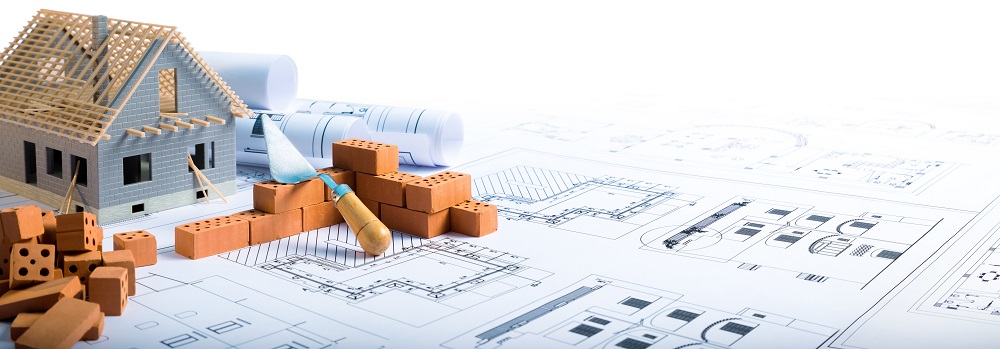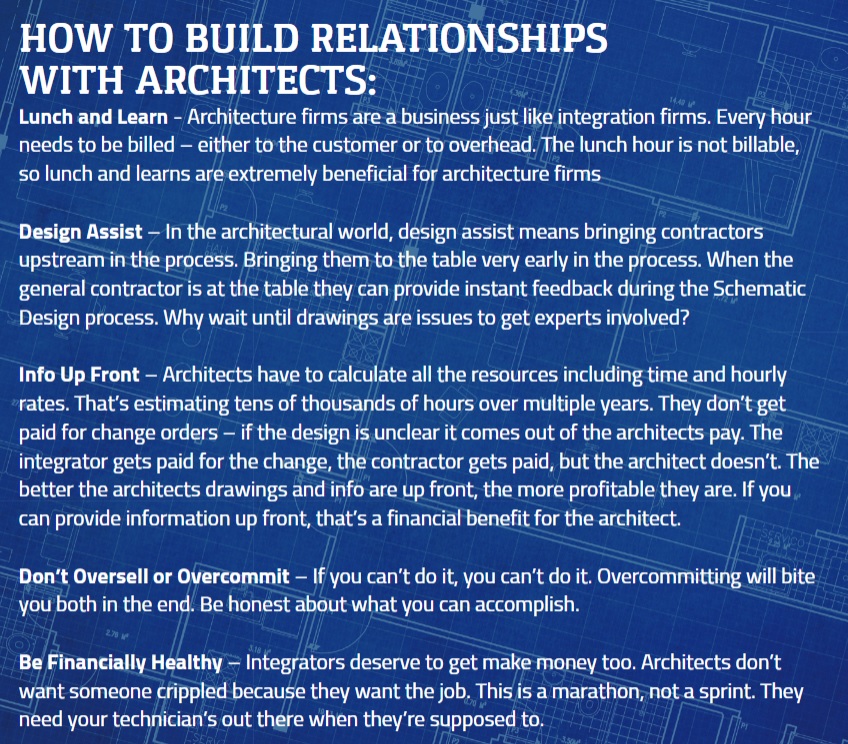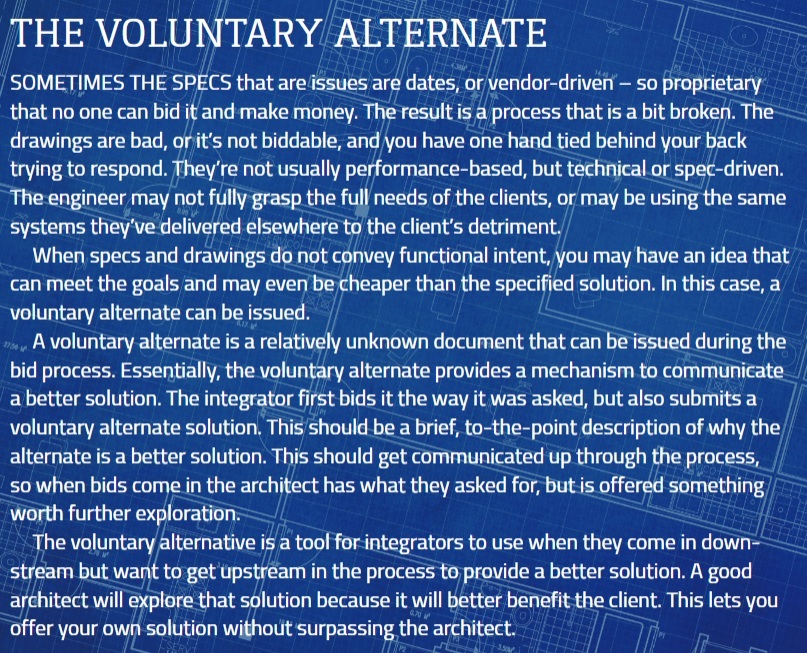
11.7.19 – CI – Jonathan Blackwood
Audio video system projects are drops in the bucket of what architects need to consider for new buildings. Here’s how installers can take full advantage.
A $1 million sale could represent a significant portion of a typical AV integration firm’s yearly audio video system project revenue.
What you might not realize, though, is in a 400,000 square-foot new building project that costs about $300 million, that $1 million on AV equipment is a blip on the radar—about .003% of the overall investment.
For too many new buildings, AV technology is simply a cog in the machine. However, it’s an extremely important cog as proper AV technology will provide the overall experience the new building is trying to offer.
The goal for integration firms is to get a seat at the table early in the process as a partner to the architect, said Peter O’Conner, associate principal of Hoefer Wysocki Architecture, during his presentation at the 2019 NSCA Pivot to Profit event.
“We enable experiences through the construction of buildings,” he said.
O’Conner designs buildings for healthcare providers and hospitals (including a $2.6 billion construction program from Scripps), but says that the experience is the same regardless of the industry.
It’s all about enabling the experience.
Everything you do in your audio video system projects needs to support a workflow and a process. Technology is simply an enabler, O’Conner said.
The Client Experience
Clients want to provide an experience to whomever they serve. They want technology to be enterprise centric. Interoperability is an expectation, not something on the wish list.
Collaboration is a requirement – if you’re not working together with the design team, other vendors, and possibly even competitors, you’re not helping the client.
According to O’Conner, questions surrounding AV technology are often not being asked during the initial phases of building design.
“This is stuff that’s missed every day in construction projects,” he said. “This is where [integrators] can help. You guys are the experts.”
O’Conner suggests integrators should create a schedule for displays.
Related: Comparing AV over IP: NONE of These is Just Like the Other
“Every display gets an ID number,” he said. “Architects have a schedule for hardware. Why don’t we do that for displays? AV should be design-build every single time. Why not have the right people at the right table right off the bat?”
That all sounds nice, but in many cases the reality is that integrators aren’t brought in until far downstream in the process. At that point, the specs have been drawn, and the bid will go to whomever can offer the lowest cost (sometimes to their own company’s detriment).
Then, during installation, getting approval for extra budget for pieces that weren’t included in the specifications is next to impossible, and gets the architect in trouble with the client.
During design, you can build $200,000 into the budget without anyone blinking. During construction, asking for an extra $2,000 is met with immense frustration.
Still, integration firms aren’t brought in early enough to get that budget approved when it should be approved. That can be the architect’s fault, but integrators can be proactive about getting involved earlier as well.
The Ripple Effect
“Your technology, whatever you might represent, is likely a small but really important piece of a complex machine,” said O’Conner.
“I’m not trying to diminish the different systems represented by integrators, but trying to show you there’s a big thing we’re trying to move down a highway, which is the project,” he said.
Any time new technology is implemented into an environment, there is a ripple effect. The first ripple is the intended effect of the technology; for example, if you provide a videoconferencing unit, you expect to be able to videoconference with remote users elsewhere.
The problem is that clients don’t see the unexpected impacts.
What is your technology going to do on the fourth, fifth and sixth ripple? What are the unintended consequences of the technology you’re implementing?
“Architects have a schedule for hardware. Why don’t we do that for displays? AV should be design-build every single time. Why not have the right people at the right table right off the bat?”
As part of the overall system there will be workflow, non-workflow, support, financial, interoperability, and infrastructure impacts.
When introducing a new technology, integrators must think past the first ripple to envision how it will impact other systems and processes.
The better and more open to understanding those unintended consequences, and the better you can communicate them, the more valuable you are to the architects.
More value will lead to more trust, which will lead to an earlier introduction to the design process.
Architects won’t just call you up and ask, though. They’re used to reaching out to integrators during the bidding process. In order to make your way upstream, you need to build relationships.
Reach out the architects whether they have a new bid or not. Explain new technology concepts and how they affect other areas.
Build that relationship so that when the time comes for the architect to explore technology in the design of a new building, you’re the firm they call on because they know they can count on you to see the big picture of your proposed audio video system projects.
Once you’ve built those relationships and earned a spot at the table, it’s time to understand how technology design fits into the standard design process of architects.
The Design Process
No matter what an architect is designing, the process remains the same.
“This is pulling the curtain back on how we design buildings,” says O’Conner. “This is important for [AV integrators] to know because this is [architects’] language. Whether you’re designing a dog house or a hospital, this is our process.”
Programming
This is where the building is a spreadsheet. Room types, measurements, hallway designs, etc. Integrators can help here by letting the architect know about anything needed that requires square footage.
Architects need to know anything with a special impact so they can do the math to figure out how much space is needed in the new building.
Schematic Design
This is where architects start laying out departments and adjacencies. They’ll look at costing models at the same time to figure out the financial expectations. They’ll also document technology needs in a narrative form. 
They also create a responsibility matrix of who is planning, documenting, budgeting, purchasing, installing, as well as base systems versus future systems and any ongoing operational expenses.
Integrators can help here by providing high-level budgeting and system information for their audio video system projects.
This is the phase where adding budget to the audio video system project is relatively easy.
This is the time to truly get the budget needed to install the systems you need – not during the bid process.
“By giving us good pricing information and good information for that functional narrative, we can set the expectation both technically and financially,” says O’Conner.
Design Development
This is where architects start meeting with the actual end users of the system. Up to this point, they’ve met with executives, but not nurses, for example.
There are typically five rounds of user meeting per department. They focus on workflow and customer/patient experience. They refine the cost model more because there is more data. They start locating devices. This is where the design drawings will be completed.
This is where O’Conner’s company comes up with the cost. A company like O’Conner’s will track both what the contractor and the customer are paying for. If the integrator doesn’t make it into this budget, it won’t be installed – or it will be an expensive changing order and the architect will be in trouble for it.
They need to know about anything that is required to make the system work that costs money before they issue this documentation.
Integrators can help here by providing detailed system info and pricing. Leverage your expertise and help solve problems. Users will offer up problems to the architect, and if you’ve built the relationship the architect will reach out to you to ask for a solution.
You can provide a huge impact here by offering unique, effective audio video system project solutions to problems architects can’t solve with their knowledge alone.
Construction Documentation
This is what integrators typically see. It’s the output of the process up to this point. After meeting with users, the architects finish out the drawings and make them constructible. That’s what the integrator sees when it goes out to bid. 
Integrators can help here by providing great spec language.
If the system is purchased by a contractor, then the specs need to be tightened up. Also, any construction details to help clarify information is helpful.
Bidding/Procurement
This is where RFPs are created, pre-bid meetings are held, and integrators get heavily involved. We’ve all been a part of these demos.
Integrators can help here by respecting the process. The spec is the spec.
The worst thing you can do is try to bypass the architect; they’ve been working with the owner for years at this point. It’s a good way to get blacklisted by that firm.
Construction Administration
Site inspections. Rough invalidation. This is where the build occurs.
Integrators can help by making sure they follow the specs in their audio video system projects. Be in sync with the schedule. Customize the deployment – make sure it does what it was intended to do. If you don’t know, ask. Put an RFI in.
Revisit the site when it’s ready to go live—and feel free to work that visit into your proposal.
